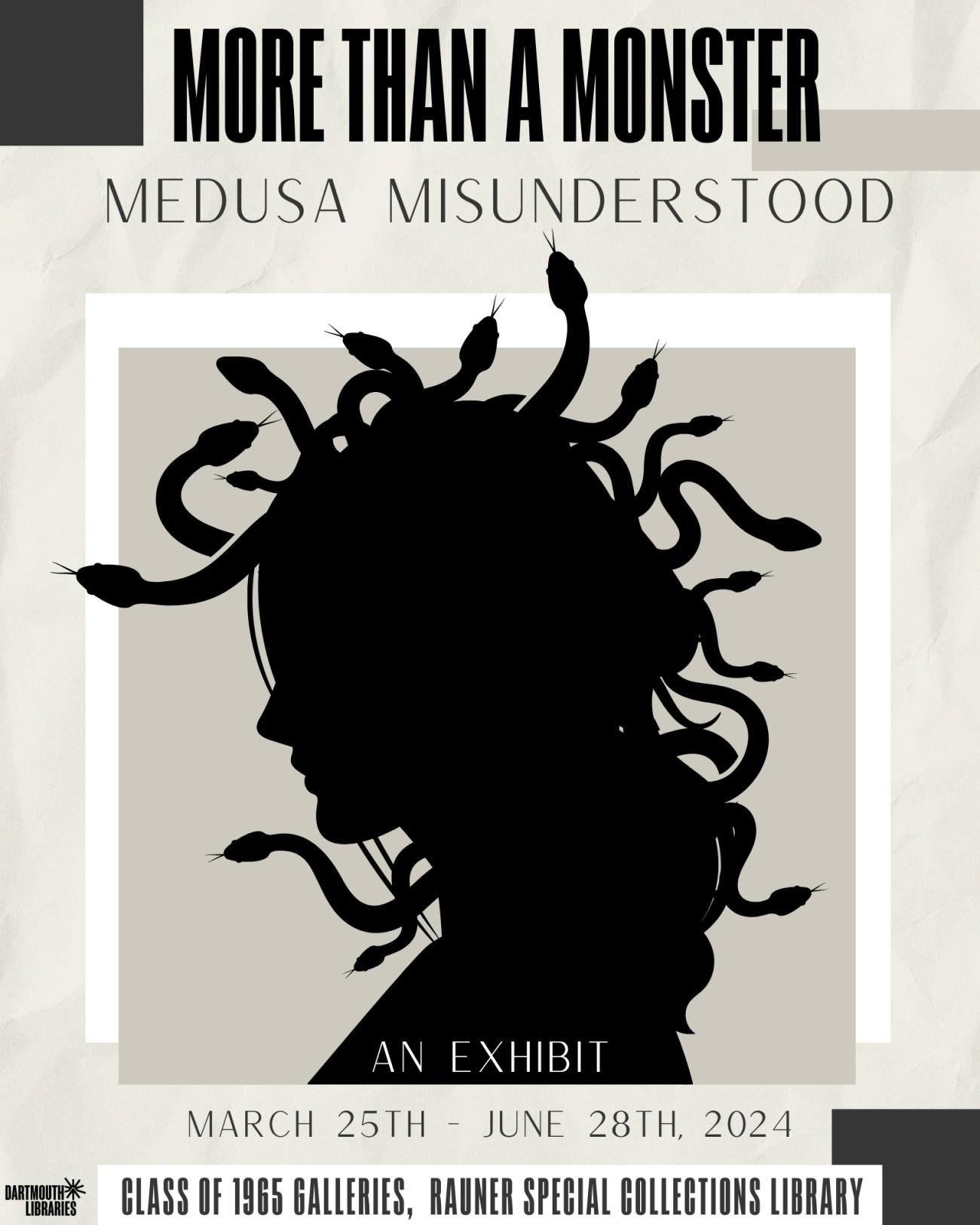The Transition of Medusa
This case highlights the spectrum of Medusas, starting with the Greek version of the myth in which she is nothing more than a monster and moving towards a more human and feminine portrayal. These works of art highlight the nuance that is buried in Medusa’s myth, and the numerous ways in which artists have chosen to render Medusa.
Henry M. Brock, Perseus Pursued by the Gorgons, The Heroes or Greek Fairy Tales for My Children, Pen and Ink, and Watercolor, 1928. MS-1447, Box 14.
Medusa’s myth actually starts with a work by Hesiod, a Greek writer. In his version, Medusa is one of three Gorgon sisters, all with snakes for hair, claws, and scales–all monsters. Ovid took Hesiod’s myth and expanded it in his Metamorphoses, making all three Gorgon sisters beautiful maidens; only Medusa is turned into a monster. This drawing by Henry Brock stays true to Hesiod’s description of the three sisters as monstrous beasts. Even though she is one of three Gorgon sisters, she is mortal, while the other two are immortal. Medusa may be more beautiful than the other Gorgon sisters in myth, but there is always something different or terrifying about her.
Vincenzo Cartari, Imagines Deorum, Lugduni, 1581. Rare BL720.C25 1581.
In this book, all three Gorgon sisters are meant to be feminine monsters: they’re wearing dresses and don’t have any claws or scales. However, their beauty is diminished by their abnormal facial proportions, again reminding the audience that they are beasts.
Nathaniel Hawthorne, A Wonder Book for Girls & Boys, Boston, 1892. Illus C85h.
The Ancient Greek mythological view and the idea of Medusa strictly as a monster pervades the 19th century. This children’s book begins with a story about King Polydectes tasking Perseus to behead Medusa. This tale holds true to the Greek myth and presents Medusa as one of the three Gorgon sisters; the surviving two hide in fright after her beheading, despite being immortal themselves. The title of the story is “The Gorgon’s Head,” a deliberate choice that robs Medusa of her name.
Andre Racz, Perseus Beheading Medusa I, 1944, Soft-ground etching and engraving on medium weight cream wove paper. Hood Museum of Art, Purchased through a gift from the Cremer Foundation in memory of J. Theodor Cremer. PR.2004.35.
This abstract engraving shows Perseus’s beheading of Medusa. Perseus is the figure on the left, Medusa’s fallen body is towards the right, and Medusa’s decapitated head is in the upper right, with blood dripping from her neck. Just like so many other representations of Medusa, this engraving is meant to be terrifying. However, in this engraving, the artist abstracts the snakes on Medusa’s head so much so that they could be mistaken for hair. In addition, Medusa’s face seems even more human than Perseus’s–you can see her eyes, nose, and mouth, and you can almost feel her agony. This engraving as a whole is monstrous because of its subject, but Medusa is clearly human; her expression evokes sympathy and pity from the audience.
Ovid, Ovid’s Metamorphoses in Fifteen Books, London, 1717. Rare PA6522.M2 G3 1717.
In this scene from Ovid’s Metamorphoses, Perseus kills Phineus with Medusa’s head. However, this representation of Medusa stands out from other more typical potrayals of her as a monster. Instead, this Medusa has smooth skin and looks innocent–even sad–and the artist has omitted all bloody evidence of her violent beheading.
Circle of Corrado Giaquinto, Perseus and Andromeda, Early-mid-18th Century, Oil on canvas mounted on board. Hood Museum of Art, Gift of Julia and Richard H. Rush, Class of 1937, Tuck 1938. P.979.141.
This painting of Andromeda, chained to the rock and waiting for Perseus to rescue her, emphasizes how feminine beauty was typically portrayed by Baroque artists: Andromeda has glowing, smooth skin, a calm face, and flowing hair. This rendition of Andromeda is remarkably similar to those of Medusa to its right and left. These Medusas have the same smooth, marble-esque skin of Andromeda, suggesting that Medusa can also be seen as not only human but as a paragon of feminine beauty.
Harriet Goodhue Hosmer, Medusa, about 1854, Marble. Hood Museum of Art, Purchased through a gift from Jane and W. David Dance, Class of 1940. S.996.24.
This sculpture demonstrates Medusa’s feminine power and defies misconceptions of her as a monster. Medusa as seen here is a strong woman–a queen, even–with snakes as her crown. Neither Medusa nor the snakes convey a sense of menace or danger. Instead, the snakes slither harmlessly around her, almost worshiping her. Here, Medusa is practically fully human: she is more than just an object or a weapon. She has more hair than snakes and isn’t just a bloody, disembodied head, but a bust, which is a format often reserved for living people, particularly important historical figures. She possesses the same soft, longing glance as Andromeda. If an observer didn’t know the story that inspired this sculpture, the viewer might not even recognize the subject as Medusa. View a 3D model of the bust via this link.
